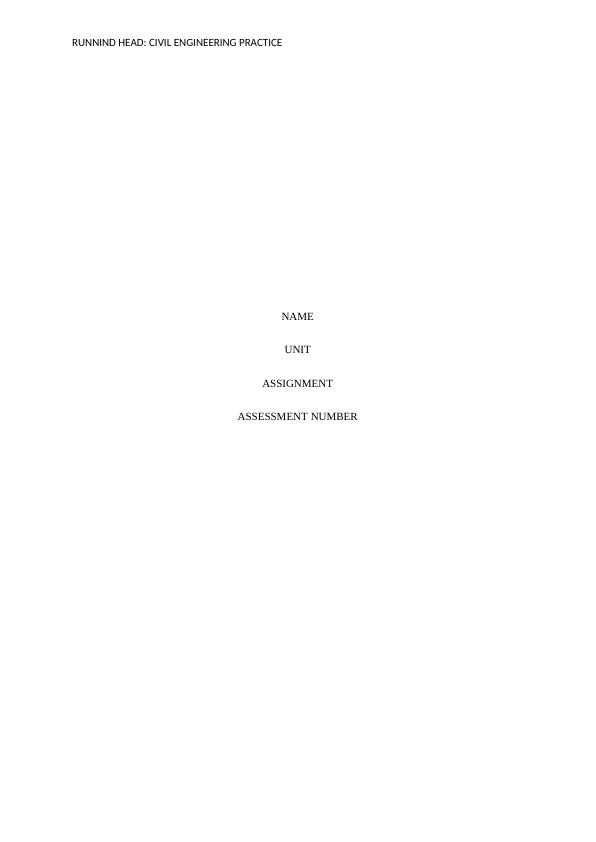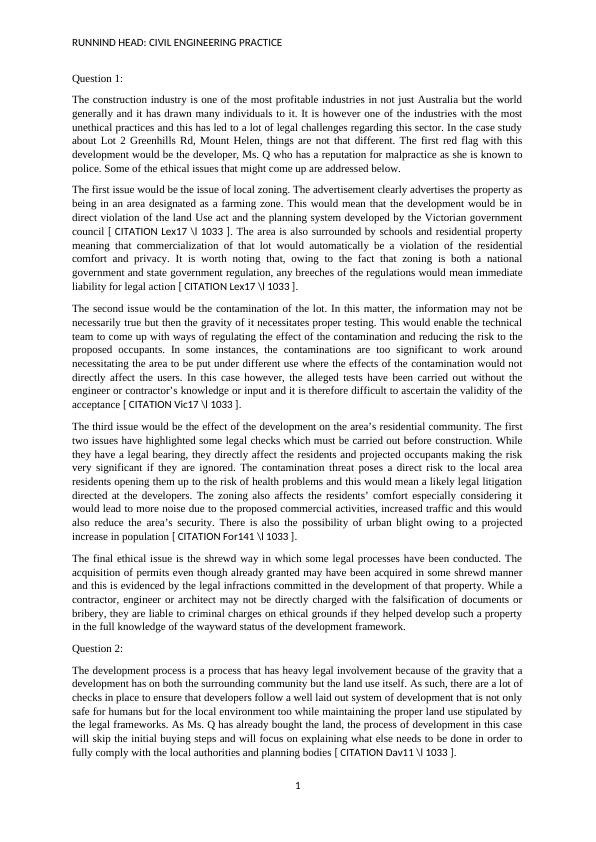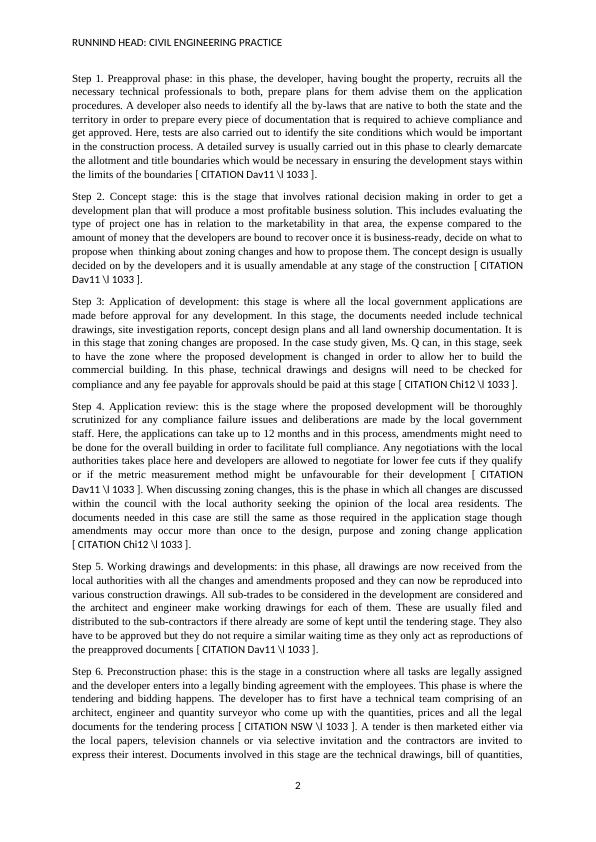Civil Engineering Practice Answers | Assignment
Added on 2019-11-25
7 Pages3353 Words168 Views
RUNNIND HEAD: CIVIL ENGINEERING PRACTICENAMEUNITASSIGNMENTASSESSMENT NUMBER

RUNNIND HEAD: CIVIL ENGINEERING PRACTICEQuestion 1:The construction industry is one of the most profitable industries in not just Australia but the worldgenerally and it has drawn many individuals to it. It is however one of the industries with the mostunethical practices and this has led to a lot of legal challenges regarding this sector. In the case studyabout Lot 2 Greenhills Rd, Mount Helen, things are not that different. The first red flag with thisdevelopment would be the developer, Ms. Q who has a reputation for malpractice as she is known topolice. Some of the ethical issues that might come up are addressed below.The first issue would be the issue of local zoning. The advertisement clearly advertises the property asbeing in an area designated as a farming zone. This would mean that the development would be indirect violation of the land Use act and the planning system developed by the Victorian governmentcouncil [ CITATION Lex17 \l 1033 ]. The area is also surrounded by schools and residential propertymeaning that commercialization of that lot would automatically be a violation of the residentialcomfort and privacy. It is worth noting that, owing to the fact that zoning is both a nationalgovernment and state government regulation, any breeches of the regulations would mean immediateliability for legal action[ CITATION Lex17 \l 1033 ].The second issue would be the contamination of the lot. In this matter, the information may not benecessarily true but then the gravity of it necessitates proper testing. This would enable the technicalteam to come up with ways of regulating the effect of the contamination and reducing the risk to theproposed occupants. In some instances, the contaminations are too significant to work aroundnecessitating the area to be put under different use where the effects of the contamination would notdirectly affect the users. In this case however, the alleged tests have been carried out without theengineer or contractor’s knowledge or input and it is therefore difficult to ascertain the validity of theacceptance [ CITATION Vic17 \l 1033 ].The third issue would be the effect of the development on the area’s residential community. The firsttwo issues have highlighted some legal checks which must be carried out before construction. Whilethey have a legal bearing, they directly affect the residents and projected occupants making the riskvery significant if they are ignored. The contamination threat poses a direct risk to the local arearesidents opening them up to the risk of health problems and this would mean a likely legal litigationdirected at the developers. The zoning also affects the residents’ comfort especially considering itwould lead to more noise due to the proposed commercial activities, increased traffic and this wouldalso reduce the area’s security. There is also the possibility of urban blight owing to a projectedincrease in population [ CITATION For141 \l 1033 ]. The final ethical issue is the shrewd way in which some legal processes have been conducted. Theacquisition of permits even though already granted may have been acquired in some shrewd mannerand this is evidenced by the legal infractions committed in the development of that property. While acontractor, engineer or architect may not be directly charged with the falsification of documents orbribery, they are liable to criminal charges on ethical grounds if they helped develop such a propertyin the full knowledge of the wayward status of the development framework.Question 2:The development process is a process that has heavy legal involvement because of the gravity that adevelopment has on both the surrounding community but the land use itself. As such, there are a lot ofchecks in place to ensure that developers follow a well laid out system of development that is not onlysafe for humans but for the local environment too while maintaining the proper land use stipulated bythe legal frameworks. As Ms. Q has already bought the land, the process of development in this casewill skip the initial buying steps and will focus on explaining what else needs to be done in order tofully comply with the local authorities and planning bodies [ CITATION Dav11 \l 1033 ].1

RUNNIND HEAD: CIVIL ENGINEERING PRACTICEStep 1. Preapproval phase: in this phase, the developer, having bought the property, recruits all thenecessary technical professionals to both, prepare plans for them advise them on the applicationprocedures. A developer also needs to identify all the by-laws that are native to both the state and theterritory in order to prepare every piece of documentation that is required to achieve compliance andget approved. Here, tests are also carried out to identify the site conditions which would be importantin the construction process. A detailed survey is usually carried out in this phase to clearly demarcatethe allotment and title boundaries which would be necessary in ensuring the development stays withinthe limits of the boundaries [ CITATION Dav11 \l 1033 ].Step 2. Concept stage: this is the stage that involves rational decision making in order to get adevelopment plan that will produce a most profitable business solution. This includes evaluating thetype of project one has in relation to the marketability in that area, the expense compared to theamount of money that the developers are bound to recover once it is business-ready, decide on what topropose when thinking about zoning changes and how to propose them. The concept design is usuallydecided on by the developers and it is usually amendable at any stage of the construction [ CITATIONDav11 \l 1033 ].Step 3: Application of development: this stage is where all the local government applications aremade before approval for any development. In this stage, the documents needed include technicaldrawings, site investigation reports, concept design plans and all land ownership documentation. It isin this stage that zoning changes are proposed. In the case study given, Ms. Q can, in this stage, seekto have the zone where the proposed development is changed in order to allow her to build thecommercial building. In this phase, technical drawings and designs will need to be checked forcompliance and any fee payable for approvals should be paid at this stage [ CITATION Chi12 \l 1033 ].Step 4. Application review: this is the stage where the proposed development will be thoroughlyscrutinized for any compliance failure issues and deliberations are made by the local governmentstaff. Here, the applications can take up to 12 months and in this process, amendments might need tobe done for the overall building in order to facilitate full compliance. Any negotiations with the localauthorities takes place here and developers are allowed to negotiate for lower fee cuts if they qualifyor if the metric measurement method might be unfavourable for their development [ CITATIONDav11 \l 1033 ]. When discussing zoning changes, this is the phase in which all changes are discussedwithin the council with the local authority seeking the opinion of the local area residents. Thedocuments needed in this case are still the same as those required in the application stage thoughamendments may occur more than once to the design, purpose and zoning change application[ CITATION Chi12 \l 1033 ].Step 5. Working drawings and developments: in this phase, all drawings are now received from thelocal authorities with all the changes and amendments proposed and they can now be reproduced intovarious construction drawings. All sub-trades to be considered in the development are considered andthe architect and engineer make working drawings for each of them. These are usually filed anddistributed to the sub-contractors if there already are some of kept until the tendering stage. They alsohave to be approved but they do not require a similar waiting time as they only act as reproductions ofthe preapproved documents [ CITATION Dav11 \l 1033 ].Step 6. Preconstruction phase: this is the stage in a construction where all tasks are legally assignedand the developer enters into a legally binding agreement with the employees. This phase is where thetendering and bidding happens. The developer has to first have a technical team comprising of anarchitect, engineer and quantity surveyor who come up with the quantities, prices and all the legaldocuments for the tendering process [ CITATION NSW \l 1033 ]. A tender is then marketed either viathe local papers, television channels or via selective invitation and the contractors are invited toexpress their interest. Documents involved in this stage are the technical drawings, bill of quantities,2

End of preview
Want to access all the pages? Upload your documents or become a member.
Related Documents
Sustainability Assessment Report for Timberwell Constructionslg...
|10
|2756
|58
